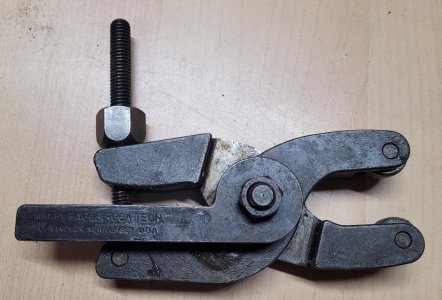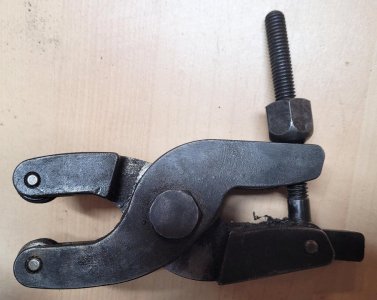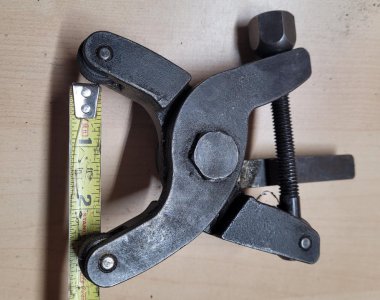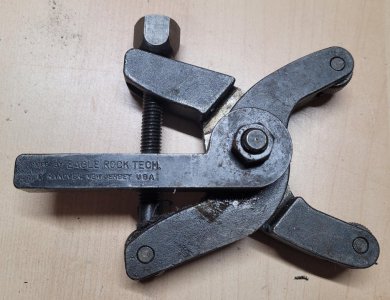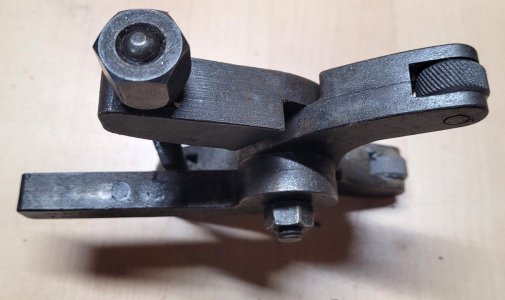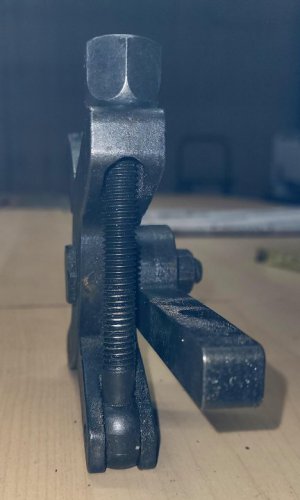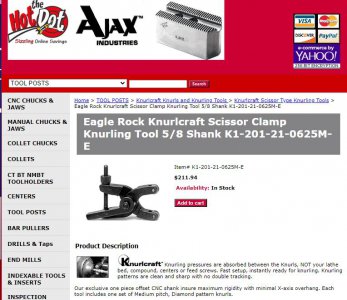I’d like some better pictures of that Eagle Rock knurler. It really looks very capable.POTD part 2 was making a couple of knurled bolts to attach the back cover to my DoAll ML saw. I don’t know what was originally used by the factory; my saw had a ¼” hex-head bolt and a cap screw in place. I only run them in finger-tight, but what the heck.
"As I got it" fasteners to hold the back cover on my DoAll ML saw
View attachment 396692
Material of choice was some ½” 303 stainless. Started with the knurl (Eagle Rock knurler). Then turned a shoulder to 0.244” and chamfered the end. Threaded with a die using the tailstock drill chuck to hold things square. Plunged in with a parting tool and chamfered both ends of the knurl, then parted. Cleaned up the nip from parting with a belt sander.
Eagle Rock knurling tool does a really nice job
View attachment 396693
View attachment 396694
Turned a shoulder
View attachment 396695
Chamfer the end prior to threading
View attachment 396696
Threading with a die using the tailstock/drill chuck to hold things square
View attachment 396697
Chamfering the knurled ends
View attachment 396698
View attachment 396699
Parting
View attachment 396700
Sanding the nib off the end
View attachment 396701
Final products
View attachment 396702
New bolts in place
View attachment 396703
Thanks for looking, Bruce
-
Welcome back Guest! Did you know you can mentor other members here at H-M? If not, please check out our Relaunch of Hobby Machinist Mentoring Program!
You are using an out of date browser. It may not display this or other websites correctly.
You should upgrade or use an alternative browser.
You should upgrade or use an alternative browser.
POTD- PROJECT OF THE DAY: What Did You Make In Your Shop Today?
- Thread starter wachuko
- Start date
- Joined
- Oct 28, 2020
- Messages
- 528
I was just thinking the same thing
- Joined
- Jul 14, 2017
- Messages
- 2,446
Today i only managed to take both cylinder heads to get pressure washed, i was looking for a place that has hot pressure washer but did not found it. One car wash said they have 400 bar, but after using there pressure gun it seems to have same pressure like the one i have home. I used a whole bottle of oven degreaser and it did not clean too well the oil is very baked on.
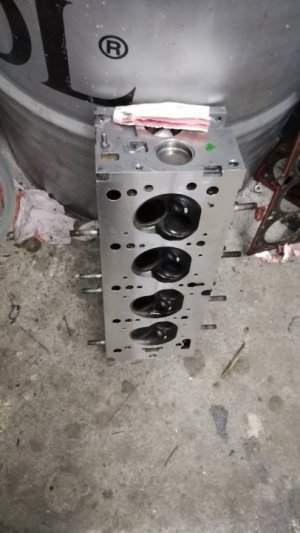

- Joined
- Dec 20, 2021
- Messages
- 865
After spending the time doing the LED upgrades on the optical comparator, it's finally getting used. FYI, the bright LED light allows me to use regular printer paper and get a good comparison. Don't really need transparency film to print on.
My favorite pocket knife is a Gerber LST. But the blade material leaves something to be desired. Picked up a couple of bars of the new 'one size fits all' knife steel, MagnaCut. Looking for a good first test knife and decided it was time to start making a new blade for the old trusty pocket knife. Spent some time with a flat bed scanner, the optical comparator, and a measuring microscope to get some good measurements on the lock design on the blade.
Here's the results from CAD compared to the lock end of the blade. Keep in mind the printed lines are about .0001" against the part being projected. Note, the camera skews some of the lines. By eye things are right on, but through the lens parts are slightly off. Getting it to this point meant tweaking line positions by tenths...
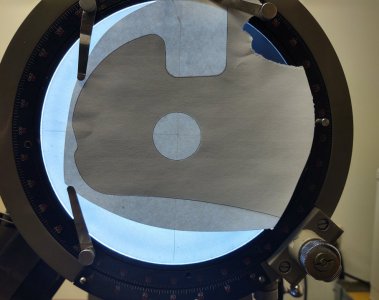
In general, it's really interesting to see the sizes of everything. I think this knife was designed in English units, as the radii, and measured dimensions seem to be in English. Getting down and dirty in the design it's pretty easy to see the decisions made when doing the geometry. A lot of things work out like radii being a 1/32" etc., distances being .150, .0625, etc., and angles seem to be nice whole degrees.
Drawing the part is one thing, Reproducing it to tenths may be another matter...
My favorite pocket knife is a Gerber LST. But the blade material leaves something to be desired. Picked up a couple of bars of the new 'one size fits all' knife steel, MagnaCut. Looking for a good first test knife and decided it was time to start making a new blade for the old trusty pocket knife. Spent some time with a flat bed scanner, the optical comparator, and a measuring microscope to get some good measurements on the lock design on the blade.
Here's the results from CAD compared to the lock end of the blade. Keep in mind the printed lines are about .0001" against the part being projected. Note, the camera skews some of the lines. By eye things are right on, but through the lens parts are slightly off. Getting it to this point meant tweaking line positions by tenths...

In general, it's really interesting to see the sizes of everything. I think this knife was designed in English units, as the radii, and measured dimensions seem to be in English. Getting down and dirty in the design it's pretty easy to see the decisions made when doing the geometry. A lot of things work out like radii being a 1/32" etc., distances being .150, .0625, etc., and angles seem to be nice whole degrees.
Drawing the part is one thing, Reproducing it to tenths may be another matter...
- Joined
- Nov 25, 2015
- Messages
- 8,272

[How-To] - Clausing 8520, 8530 New Quill lock like a BP
Well, I didn't like the quill stop. it was not stable enough, and often fell out. So I was learning Freecad, produced a model. I have to say this is my first attempt working from the plans of the freecad drawing. I like it. I made quick work of it... I made one mistake with the dro, rather than...
 www.hobby-machinist.com
www.hobby-machinist.com
- Joined
- Dec 18, 2019
- Messages
- 6,433
Doesn't even rise to POTD, maybe POTH, but here goes.
Tried rust bluing this afternoon. Made up a solution of 1/4 cup of 12% hydrogen peroxide into 1/4 cup of filtered warm water and added a tablespoon of table salt to it. Mixed it up in a little disposable kitchen container. Threw in the 6 tee-nuts I had made for my rotary table. I had previously soaked the tee-nuts in hot water and dish detergent overnight. Actually renewed the water and detergent 3 times to try to get rid of any oil. Solution started bubbling and turning rusty. After a couple of minutes, I took out the tee-nuts and stuck them on a sheet of scrap cardboard. Then using a hot air gun, dried off the solution. More rust. Kind of weird considering that all my life I have been trying to avoid it. Now I was trying to get things rusty.
Using a old toothbrush, lightly brushed off any loose rust. Then tossed the "carded" tee-nuts into a pot of boiling water. Left it in the boiling water for 5 minutes. Well, the magic of better living through chemistry happened, and that orange stuff turned dark black. The first time through was a little splotchy, and a bit disappointing, but the process needs to be repeated. I repeated 3 more times. On the fourth time, there was no reaction, my solution was spent. Mixed up another, and wow, pretty vigorous again. Boiled the tee-nuts again and pulled them out. Have to say, for less than an hours worth of work, they came out pretty good, much better than I expected. Won't win the best blue in show, but perfectly nice for my rotary table.
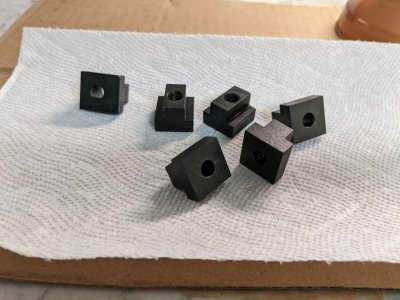
I think the bluing isn't that good in the threads, maybe due to residual oil, but overall, have to say I like this. Next time, I'll probably boil the parts in TSP first. I didn't' want to do that with our kitchen pots. Have to find a cheap pot somewhere.
Tried rust bluing this afternoon. Made up a solution of 1/4 cup of 12% hydrogen peroxide into 1/4 cup of filtered warm water and added a tablespoon of table salt to it. Mixed it up in a little disposable kitchen container. Threw in the 6 tee-nuts I had made for my rotary table. I had previously soaked the tee-nuts in hot water and dish detergent overnight. Actually renewed the water and detergent 3 times to try to get rid of any oil. Solution started bubbling and turning rusty. After a couple of minutes, I took out the tee-nuts and stuck them on a sheet of scrap cardboard. Then using a hot air gun, dried off the solution. More rust. Kind of weird considering that all my life I have been trying to avoid it. Now I was trying to get things rusty.
Using a old toothbrush, lightly brushed off any loose rust. Then tossed the "carded" tee-nuts into a pot of boiling water. Left it in the boiling water for 5 minutes. Well, the magic of better living through chemistry happened, and that orange stuff turned dark black. The first time through was a little splotchy, and a bit disappointing, but the process needs to be repeated. I repeated 3 more times. On the fourth time, there was no reaction, my solution was spent. Mixed up another, and wow, pretty vigorous again. Boiled the tee-nuts again and pulled them out. Have to say, for less than an hours worth of work, they came out pretty good, much better than I expected. Won't win the best blue in show, but perfectly nice for my rotary table.

I think the bluing isn't that good in the threads, maybe due to residual oil, but overall, have to say I like this. Next time, I'll probably boil the parts in TSP first. I didn't' want to do that with our kitchen pots. Have to find a cheap pot somewhere.
- Joined
- Nov 25, 2015
- Messages
- 8,272
I always save pots for stuff like this. Also picked up a hot plate at a garage sale, so I can avoid doing stuff in the kitchen.Doesn't even rise to POTD, maybe POTH, but here goes.
Tried rust bluing this afternoon. Made up a solution of 1/4 cup of 12% hydrogen peroxide into 1/4 cup of filtered warm water and added a tablespoon of table salt to it. Mixed it up in a little disposable kitchen container. Threw in the 6 tee-nuts I had made for my rotary table. I had previously soaked the tee-nuts in hot water and dish detergent overnight. Actually renewed the water and detergent 3 times to try to get rid of any oil. Solution started bubbling and turning rusty. After a couple of minutes, I took out the tee-nuts and stuck them on a sheet of scrap cardboard. Then using a hot air gun, dried off the solution. More rust. Kind of weird considering that all my life I have been trying to avoid it. Now I was trying to get things rusty.
Using a old toothbrush, lightly brushed off any loose rust. Then tossed the "carded" tee-nuts into a pot of boiling water. Left it in the boiling water for 5 minutes. Well, the magic of better living through chemistry happened, and that orange stuff turned dark black. The first time through was a little splotchy, and a bit disappointing, but the process needs to be repeated. I repeated 3 more times. On the fourth time, there was no reaction, my solution was spent. Mixed up another, and wow, pretty vigorous again. Boiled the tee-nuts again and pulled them out. Have to say, for less than an hours worth of work, they came out pretty good, much better than I expected. Won't win the best blue in show, but perfectly nice for my rotary table.
View attachment 397140
I think the bluing isn't that good in the threads, maybe due to residual oil, but overall, have to say I like this. Next time, I'll probably boil the parts in TSP first. I didn't' want to do that with our kitchen pots. Have to find a cheap pot somewhere.
That almost looks nice, but there's a lot of pitting I see. Is that from the loose rust? Anyway to get a nice smooth finish like a black oxide on a screw or any black ox tooling?
I might have to give that a try.
- Joined
- Dec 18, 2019
- Messages
- 6,433
Considering that I didn't polish the original tee-nuts to a mirror finish, it's hard for me to say if there is pitting. The pieces were raw machined and deburred, but not polished. I compared the finish to a commercial tee-nut and it is pretty close. As I mentioned, I only used a nylon bristle toothbrush for the rust removal. I didn't have any oil-free fine steel wool, which may have done a better job. Most steel wool does have some oil in it. Not good for this, since the oil will inhibit the chemical reaction.I always save pots for stuff like this. Also picked up a hot plate at a garage sale, so I can avoid doing stuff in the kitchen.
That almost looks nice, but there's a lot of pitting I see. Is that from the loose rust? Anyway to get a nice smooth finish like a black oxide on a screw or any black ox tooling?
I might have to give that a try.
Give it a try, it is incredibly easy.
Do wear gloves. It keeps oils from your hands getting on the pieces. Also, the black oxide gets on things. I took off my gloves too soon, before oiling the tee-nuts. Bad idea. Fingertips are darkened. Some of it came off when I washed my hands!
Edit: One of the faces wasn't even machined, just raw stock.
Last edited:


